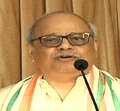| Calcutta High Court | |
|---|---|
| কলকাতা উচ্চ আদালত | |
 Calcutta High Court building | |
 Interactive map of Calcutta High Court | |
| 22°34′6″N88°20′36″E / 22.56833°N 88.34333°E | |
| Established | 1 July 1862 |
| Jurisdiction | West Bengal and Andaman & Nicobar Islands |
| Location | Principal Seat: Kolkata, West Bengal Circuit Benches: Jalpaiguri & Port Blair (A & N Islands) |
| Coordinates | 22°34′6″N88°20′36″E / 22.56833°N 88.34333°E |
| Composition method | Presidential with confirmation of Chief Justice of India and Governor of respective state. |
| Authorised by | Constitution of India |
| Judge term length | Till 62 years of age |
| Number of positions | 72 |
| Website | calcuttahighcourt.gov.in |
| Chief Justice | |
| Currently | Sujoy Paul (Acting) |
| Since | 8 October 2025 |
Calcutta High Court is the oldest High Court in India. [1] It is located at Esplanade Row West, Kolkata, West Bengal. It has jurisdiction over the state of West Bengal and the Union Territory of the Andaman and Nicobar Islands. The High Court building's design is modelled on the Ypres Cloth Hall in Flanders, Belgium. [2]
Contents
- History
- Principal seat and benches
- Chief Justice
- List of Chief Justices
- Judges
- Judges elevated to Supreme Court
- Currently serving
- Former judges
- Building
- Connectivity
- Rails
- References
- External links
Currently, the court has a sanctioned judge strength of 72.
















